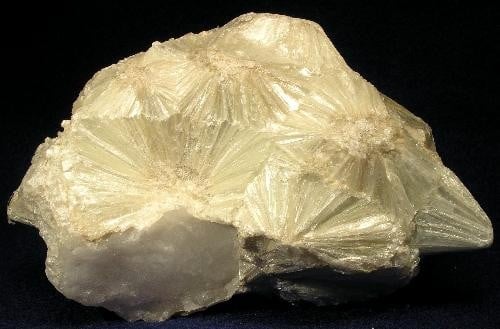Pyrophyllite Value, Price, and Jewelry Information
Pyrophyllite resembles talc in many ways and is indistinguishable by eye from soapstone. Chemical tests are needed to distinguish them. North Carolina material is often used in carvings, as is the material from China known as agalmatolite.
Pyrophyllite resembles talc in many ways and is indistinguishable by eye from soapstone. Chemical tests are needed to distinguish them. North Carolina material is often used in carvings, as is the material from China known as agalmatolite.
Start an IGS Membership today
for full access to our price guide (updated monthly).Pyrophyllite Value
Optics: a = 1.534—1.556; β= 1.586-1.589; γ= 1.596-1.601.
Biaxial (-), 2V = 53—62°.
Vague shadow edge on refractometer at about 1.6.
Occurrence: In schistose metamorphic rocks; also in hydrothermal veins with micas, quartz.
California; Arizona; Deep River, North Carolina; Pennsylvania; Georgia.
Minus Gerais, Brazil; Mexico; Sweden; Belgium;
Switzerland; Japan; USSR; Korea.
Transvaal, South Africa: so-called koranna stone, which is dark gray and is about 86% pyrophyllite; R.I. ~ 1.58, S.G. 2.72; also called South African Wonderstone.
Comments: Pyrophyllite resembles talc in many ways and is indistinguishable by eye from soapstone. Chemical tests are needed to distinguish them. North Carolina material is often used in carvings, as is the material from China known as agalmatolite.
Name: From the Greek words for fire and leaf because of the sheet-like nature and thermal properties of the mineral. Agalmatolile means figure stone, in allusion to its use in carvings.
Joel E. Arem, Ph.D., FGA
Dr. Joel E. Arem has more than 60 years of experience in the world of gems and minerals. After obtaining his Ph.D. in Mineralogy from Harvard University, he has published numerous books that are still among the most widely used references and guidebooks on crystals, gems and minerals in the world.
Co-founder and President of numerous organizations, Dr. Arem has enjoyed a lifelong career in mineralogy and gemology. He has been a Smithsonian scientist and Curator, a consultant to many well-known companies and institutions, and a prolific author and speaker. Although his main activities have been as a gem cutter and dealer, his focus has always been education. joelarem.com
Related Articles
Black Diamond Value, Price, and Jewelry Information
Chameleon Diamond Value, Price, and Jewelry Information
Gray Diamond Value, Price, and Jewelry Information
Green Diamond Value, Price, and Jewelry Information
Latest Articles
Quartz Toxicity: Understanding the Risks for Jewelers and Wearers
Synthetic Amethyst: What is it and How is it Made?
Hambergite Value, Price, and Jewelry Information
Pearl Simulants: How to Spot Faux Pearls
Never Stop Learning
When you join the IGS community, you get trusted diamond & gemstone information when you need it.
Get Gemology Insights
Get started with the International Gem Society’s free guide to gemstone identification. Join our weekly newsletter & get a free copy of the Gem ID Checklist!
